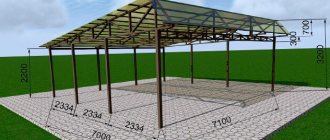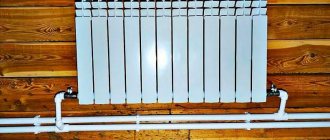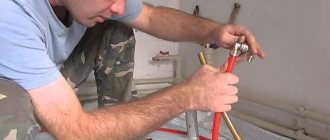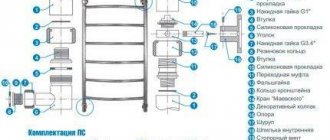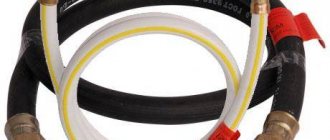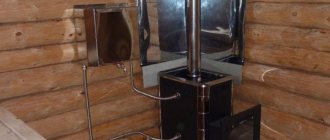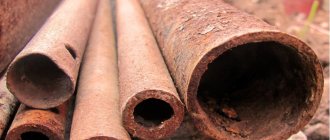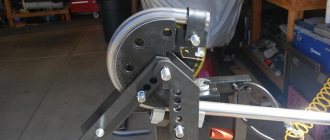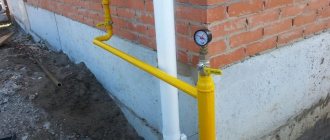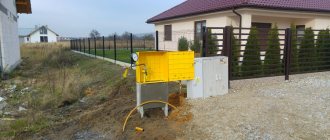High humidity and poor ventilation lead to mold on bathrobes, towels and bathroom trim. To dry things and air in the room, you can use a heated towel rail - a device that is connected to the mains or water coolant.
Most often, the device is installed in a hot water supply or heating riser, so in order to avoid accidents, you must strictly follow the rules for installing a heated towel rail.
Is it possible to connect a towel dryer to the hot water supply?
Yes you can.
Moreover, connecting devices to the hot water riser allows you to organize uninterrupted operation of the heated towel rail throughout the year. All the disadvantages of the traditional method are eliminated, the bathroom is always warm and dry.
In addition, the method of accounting for utilities is changing - when a heated towel rail is powered from a hot water riser, it ceases to be considered a heating device, and the thermal energy consumed is taken into account only as the cost of heating water for domestic hot water.
Finally about combined dryers
A double-circuit heated towel rail perfectly solves the problem of seasonality when connecting to home heating. During the cold season, the water circuit is heated; at the end of the heating season, you can turn on the second electric coil. The mounting of the device is quite ordinary - on brackets, the connection is made immediately to 2 networks - electrical and heating.
If it is necessary to change the old Soviet coil in an apartment, then the new one does not have to be installed in the same place and connected to the existing fittings. It is very advisable to replace the riser - it is probably “overgrown” with rust. Choose a suitable location for the heater, sketch out the connection diagram and install the heated towel rail according to the new requirements.
Basic installation rules
Powering the substation from the DHW line should not violate the rights of other users. Therefore, the installation of devices must be carried out in compliance with all requirements and standards.
The basic rules for connection are:
- using bypass;
- the absence of shut-off valves on the bypass, which can be used to cut off users of the upper floors from the hot water supply;
- the distance from the riser to the substation should not exceed 2 m so that the water temperature remains within standard limits;
- The bypass capacity must meet the technical requirements for a given network and not interfere with the water supply to other subscribers.
In addition, it is necessary to take into account the characteristics of water circulation . When installing the device at a great distance from the riser, it is necessary to ensure a slight slope of the pipes - on the lower branch the pipe slopes towards the riser, and on the upper branch - away from it. This allows for the free removal of air bubbles and increases the intensity of circulation.
Often these rules are violated by management company employees themselves, who use obviously unsuitable types of pipes or incorrect connection methods. Therefore, to avoid errors, the apartment owner should have a clear understanding of the correct connection of the substation to the pipeline.
Principle of operation
First of all, let’s figure out what modern heated towel rails are. As a rule, we are talking about a pipe of a zigzag design, which is installed on the wall of the bathroom and connected to the hot water supply circuit. In older designs, the operation of which was based on the continuous circulation of a heated coolant fluid, the so-called “loop” principle was used. At the same time, the residents of the multi-storey building were provided with hot water, which was supplied through pipes from the upper floor to the lower ones, and when the water flow reversed from the bottom up, heat was collected for the heated towel rails.
The main technological condition for the correct connection of the heated towel rail was that its loop-shaped pipe corresponded in diameter to the pipes of the riser itself. Only in this way was the correct circulation of the coolant in the hot water supply circuit ensured without excessive hydraulic resistance.
How does the shape of the device affect installation?
The efficiency of water circulation and the absence of stagnant or airy areas depend on the shape of the heated towel rail.
The most effective are U- or M-shaped structures that do not have complex intersections or bends.
Water enters them from one end of a curved pipe and leaves the other without changing its speed or stopping.
However, modern substation designs, made in the form of ladders or in the form of complex spatial lattices, are more convenient for operation. They provide more options for drying towels, but require proper connection.
Chapter contents (list):
After loading the page, transitions through the lists are instantaneous (i.e., they do not require separate downloads, since they are already downloaded to your computer).
1). Where should you start? 2). Reliable product and components, possible defects, pre-installation preparation. 3). Examples of different ways to connect a heated towel rail. 4). Preparation for dismantling, shutdown, draining the coolant. 5). Dismantling, cutting, safety measures, insurance. 6). Preparation for installation. 7). Installation. 8). Additional information on the topic.
№1
Attention! Almost all repair and installation work in water heating systems is equivalent to complex plumbing work.
The highest quality result when replacing heating (and any other) systems can be obtained if everything is changed, entirely from new material, starting with reliable shut-off valves.
* Of course, subject to the use of certified materials and components, as well as truly professional installation.
A new heated towel rail is almost never installed on the threaded outlets of an old pipeline (which, by the way, may not exist - a completely welded structure). The main reason for this is the absolute lack of a decent design for such an assembly, and also the fact that the purchased “coil” will most likely not coincide with them along the lines. axial distance of threaded connections.
But in any case, you should not start with the purchase of a new product and components. The first and most important thing to do is to talk to the neighbors from the apartments whose pipes come into your apartment. Until you clarify the condition of their pipelines and what is the likelihood of them being damaged during your work, it is unacceptable for you to either disassemble, cut or cut them.
For example, if steel pipes directly behind a wall (or ceiling) are cut and replaced with plastic (or any other relatively soft modern material), then they can be very easily damaged. Torsional loads on the pipe are also extremely undesirable if the connections of individual sections of the pipeline in other people's apartments are made using threaded elements. The most correct (and often the only possible) option in such cases would be to route your new pipeline to adjacent apartments (this will be the best option for you in any case). The likelihood that you will be refused is not very high - replacing old scraps inside the walls (floors) is also in the interests of your neighbors (the most important thing is to explain this clearly).
* However, if your neighbors are elderly, haven’t changed anything and don’t intend to do so, then you can’t really count on achieving “consensus” even if the pipe is at a critical stage of wear.
If you are denied connection to new pipes (as a rule, this happens when pipelines are sewn into walls or recessed into the floor), then the complexity of the work and the likelihood of damaging someone else’s pipe increases significantly, compactness is lost, and the new pipeline will ultimately be divided an old piece of rusty, half-rotten pipe left in the ceiling or wall.
* During the installation of your connection, damage to the “soft” pipeline of your neighbors is very likely. As a rule, after this they have no other choice but to provide access to their communications (sometimes for this purpose they break the pipe on purpose, turning it from their side). However, it is very difficult to predict all possible scenarios for the development of events in this case (and they can be very different, for example, a case of conflict between neighbors over this issue with a fatal outcome has been documented).
It’s even worse when the adjacent apartment is uninhabited and where the owners are is unknown. It is necessary to find out this, and until you have such information, you cannot begin work.
* By the way, when you negotiate about connecting to pipes on someone else’s territory, don’t even think about offering your neighbors to pay for part of the work or materials. They are unlikely to tolerate such impudence, and in the end you may be left with a “nose”.
№2
Let's consider replacing the heated towel rail using the most common option, based on the fact that your neighbors have not changed anything (but nevertheless, an inspection and check of the condition of their communications is necessary). Only after all of the above (paragraph No. 1) do we proceed to purchase a reliable product, pipe, fittings, and other components.
Connection diagrams in the apartment
The operation of a heated towel rail requires constant circulation of water. If its shape is close to the standard U- or M-shaped types, only one connection option is possible.
If a modern substation design with several connection points is used, you will have to choose the best option. This issue should be taken seriously, since it will be extremely difficult to correct the mistakes made.
Existing options
There are several ways to connect a substation to a hot water riser. All of them apply only to complex structures that have 4 connection points (in the form of a ladder).
Depending on the configuration of the room, the size of the substation and other factors, different schemes can be used:
Upper. Direct and reverse taps are connected to the upper points of the substation.- Bottom. The forward and return pipelines are connected to the lower connecting elements.
- Lateral. For connection, use one upper and one lower connecting elements located on one side of the device.
- Diagonal. Upper and lower connecting elements are used, located on different sides of the ladder.
- In the center. This connection option is less common. The ladder has only 2 connection points located on the upper and lower rungs.
All options have their pros and cons. It is difficult to clearly name the best connection method, since many factors affecting the operating conditions of the device must be taken into account.
How to choose the right method?
The choice of the optimal connection method is determined by the need to get the maximum benefit from the heated towel rail and eliminate the loss of thermal energy. To do this, it is necessary to ensure water circulation and the absence of stagnant or airy areas.
It is necessary to take into account the size of the device, width and number of crossbars. In addition, the direction of supply (from above or below), the pressure in the system and the speed of water movement should be taken into account.
Most experts consider side mounting to be the best option.
It has minor drawbacks, but allows for a minimum of thermal energy losses and ensures efficient water circulation.
The bottom connection can be used in any direction of flow in the riser. The upper type of connection creates the danger of water stagnation in the lower part of the device, where the cooled layers sink.
Designs with centrally located pipes are considered the most successful, but they are much less common on sale.
In addition to the connection points, a properly functioning bypass is required. This is a straight section of the riser located between the branches at the substation. There should not be any valves on it, and the internal diameter should not be reduced relative to the rest of the pipeline.
Sometimes the bypass is shifted relative to the common spine of the riser. This is done only in systems of private houses, since there is a danger of changing the flow parameters.
All these options apply only to ladder-shaped devices. Conventional U- or M-shaped heated towel rails have only two connection points and are connected in a single way.
What schemes should you avoid?
First of all, it is necessary to avoid the use of complex bends that are curved and form vertical loops. Air bubbles form in them, which impede the movement of water. In addition, it is necessary to maintain the slope of the branches.
Often, apartment owners, wanting to hide pipes, lay them in a concrete floor screed or under a suspended ceiling. This creates extended loops where stagnant areas form and air accumulates.
In systems with low operating pressure (usually this happens in autonomous lines of private houses), it is necessary to take into account the direction of supply . There are often situations when forced circulation begins to compete with natural circulation.
Hot water enters the substation, cools down in it and begins to fall down. In such cases, the flow either passes along one path without heating the rest of the heated towel rail, or stops altogether.
What designs are there?
Heated towel rails come in different shapes. When choosing them, people are often guided solely by aesthetics, which is not entirely justified. These devices work normally with good water circulation, but not all models provide such circulation. With some you have to spend a long time trying to find the right connection diagram, otherwise they simply refuse to work.
So, all heated towel rails can be divided into four groups:
- U-shaped or U-shaped. The simplest models, basic connection (lateral). Ideally, when replacing the old one, you find a model with the same center distance. Then, if you're lucky, you won't even have to redo the bends.
- Ladder. Modern designs with a certain number of crossbars. Also a good option from a hydraulic point of view. The connection can be bottom, side or diagonal. But it is not chosen arbitrarily, but according to a set of conditions (where the supply comes from, location relative to the riser).
- Snake. Another classic model with side connection. Installing a heated towel rail of this type, as a rule, does not present any problems.
- Complex shape. There are very unusual heated towel rails. They can even be an interior decoration, but their proper connection is a problem. As a rule, consultation with a competent specialist, a plumber who is well versed in hydraulics, is required. As you understand, finding one is not an easy task.
It often happens that after installing a heated towel rail it simply does not work. If the error is serious, the riser to which it is connected also stops working. Therefore, it is necessary to know and follow the connection rules.
Step-by-step instruction
There are many options for connecting the substation to the riser, so it is necessary to consider them separately.
Lateral horizontal installation
This option is simple and popular.
To connect, you must perform the following steps:
- Using standard fasteners, install the heated towel rail on the wall;
- Mark the tie-in points on the riser. They must be located so that the required angle of inclination of the bends is maintained.
- Turn off the water in the riser, drain the remaining water and relieve the pressure (just open the tap).
- Cut out a section of pipe, or burn holes in it for bends.
- Measure and cut two pieces of pipe from which the elbows will be made. Shut-off valves are immediately installed - usually ball valves.
- Weld the bends directly to the riser or using fittings (tees).
- Connect the pipelines to the heated towel rail using “American” nuts (internal threaded union nuts).
Taps should not be placed on the bypass, so as not to accidentally turn off the water for other users. There are two bypass design options that should be especially considered.
Narrowed bypass
Often the bypass is made from a pipe with a diameter that is one register smaller. Usually, they simply weld a piece of thinner pipe inserted into the gap. This is done in order to redistribute the flow in the straight section of the riser.
This method allows you to increase the flow of water into the heated towel rail, which makes it work more efficiently. However, if you need to turn it off, the DHW supply mode will change. This is noticeable even when installing a narrowed bypass in one apartment.
Since this method creates the possibility of violating water supply regulations, its use is considered a risky and undesirable solution.
Not narrowed bypass
A non-narrowed bypass allows you to maintain the throughput of the riser. This is the best option to ensure that the technical characteristics of the system are maintained.
However, in this case, the operating efficiency of the PS may be reduced due to the high hydrodynamic resistance of the device. If the heated towel rail has a large volume with many bars, stagnation of cooled water may occur, stopping the flow into the device.
Another thing to pay attention to is the size of the ball valves. If their capacity is too small, the flow will enter the PS with low intensity, reducing the efficiency of the device. It is recommended to take care in advance of purchasing taps that do not reduce the cross-section of the pipe.
Bottom installation
The lower connection allows you to connect pipes without making channels in the walls (without gating).
However, it is necessary to ensure that the tie-in points into the riser are at a distance of at least 50 cm from each other and are located below the connecting elements of the substation. With this method, it does not matter whether the water is supplied from below or from above.
Installation procedure:
- Install the device on the wall using the supplied fasteners.
- Turn off the water and relieve pressure. Mark the connection points for the branches on the riser.
- Cut a section of pipe and install fittings (or burn holes to directly connect metal pipes).
- Make bends with installed ball valves.
- Connect the outlets to the riser and to the heated towel rail.
The photo shows a connection diagram for a heated towel rail with bottom outlets:
This option is convenient because for repairs you do not have to destroy most of the finishing of the room.
Diagonal installation
This is a variant of lateral connection, in which the lower outlet is made from the distant connecting element.
Procedure:
- The device is installed on the wall.
- The water is turned off, and the installation points for outlets with the required slope are marked on the riser.
- Branches with shut-off valves are prepared.
- The short (upper) and long (lower) branches are connected.
This connection option can be done in reverse - a long outlet on top, a short one on the bottom. The main requirement is that the diameter of the bypass and riser must be equal.
Operating experience shows that the diagonal method has no advantages over the usual lateral method.
Universal option
Universal connection is not a separate option, but another name for the lower connection method.
The term arose due to the high efficiency of the PS installed in this way. The procedure is no different from that discussed above, all requirements are also similar.
Sometimes there is another interpretation of the term, when it refers to the connection of a conventional U- or M-shaped heated towel rail. Since the term does not have an exact formalized definition, discrepancies may arise.
Additional types of connection
There are other installation schemes for a heated towel rail:
- With offset bypass. This option is used to enhance the flow energy entering the device. In direct flow, water moves more actively along the riser, which can cause stagnation and cooling of the flow in the substation. The design of the offset bypass provides for a smooth bend of the inlet sections of the riser adjacent to the outlets and bypass. The flow is directed horizontally, which increases the efficiency of the substation.
- With central connecting element. This method is simple because the device has only two connecting elements. Installation consists of installing the substation on the wall and assembling taps for the hot water riser.
These options are used less frequently - the first is more labor-intensive and requires experience from the master, and the second is simply relatively rare.
Types of American taps for heated towel rails
Straight American cock
American cranes can be classified according to several criteria. For example, according to their design, there are two types: petal and lever valves. For installation of heating system elements, petal-type devices are more often used. Lever valves are usually installed on smaller diameter pipes.
There are also straight and corner American fittings for heated towel rails, designed for straight sections of water supply and corner connections, respectively.
The fitting material can also be different:
- brass coated with chrome or nickel;
- cast iron;
- steel, usually stainless;
- combined materials with polypropylene inserts.
According to the type of connecting joints, “American” ones can be divided into two groups:
- Cylindrical: fittings are sealed using gaskets made of rubber, polyurethane or paronite. The seal in the connection needs to be replaced regularly. And the connection itself must be tightened regularly.
- Conical ones do not require additional sealing, so they are often used when installing heated towel rails. They have a longer service life and create a uniform joint.
Note: if the deviation of the pipe axes is no more than five degrees, the connection with the cone valve will be absolutely sealed, resistant to temperature changes and other influences.
Common mistakes
The main and unacceptable mistake is the absence of a bypass, or the installation of a ball valve on it.
If it is closed, hot water will stop flowing to other apartments located further along the riser.
Another mistake is excessively narrowing the bypass. As a rule, plumbers motivate their actions by the fact that there is no difference - the water still passes through the substation and returns to the riser.
However, if the device is shut off, the water pressure for other subscribers decreases sharply. In MKD systems, the difference between standard and changed pressure becomes critical.
In addition, bends from the riser are often made that have humps, a lot of curved sections , and fittings. All these elements create the possibility of the formation of air bubbles that stop circulation.
Correcting these errors without completely reworking the connection is impossible.
The best option is to think through the installation process in advance and avoid making any mistakes.
Installing a towel dryer with your own hands
Today, it is quite difficult to imagine a bathroom without a heated towel rail. This important attribute occupies a vital place in our homes and apartments. In addition to the fact that this device instantly dries our towels, it even regulates the air and climate in the room. Everyone knows that bathrooms are dominated by humidity, dampness, etc. And in order to avoid unpleasant odors, it is necessary to install a heated towel rail. We will find out in the article exactly how this is done.
Some people install this device themselves. But basically, it is recommended to invite professional plumbers who are quite well versed in every detail. Whatever decision you make, in this article you will read a clear description of connecting and installing a heated towel rail. This is done quite easily and simply. Step-by-step instructions will help anyone understand the simplest details.
Why are parts chromed?
A layer of chromium applied to the surface of the metal forms an oxide protective film that prevents the iron from reacting with oxygen and rusting.
In addition to this main function, chrome, due to its silvery-white color with a bluish tint, perfectly fulfills a decorative role.
And finally, this metal is one of the hardest, it gives the workpiece additional strength.
Building regulations
The height of the lower edge of the heated towel rail from the floor, based on SNiPs, is permissible at 90 cm, provided that it is an M-shaped coil or a ladder. The top edge should not be higher than 1.70 m. For a bowl, the value is 30 cm higher, and for the combined type 1 m. It is recommended to maintain a distance of 60 cm from the doorway and wall cabinets with shelves. The same applies to the mixer, bathtub, shower cabin. For electrical appliances, the minimum distance is 70 cm.
In small bathrooms, standards are often violated. This can be explained by the lack of standards in the construction and engineering of bathrooms. But there are requirements that must be met in any case:
- access to all communications must be open;
- using the dryer should be safe and comfortable;
- cannot be hung over a bathtub, but is acceptable over a sink or side-loading washing machine;
Electric rotary dryer Source dizainexpert.ru
- sockets must be grounded and connected to a separate circuit breaker; they can be installed indoors only if there is proper ventilation;
- the distance from the wall is maintained in accordance with the thermal expansion of the finishing material of the walls, but not less than 30-55 mm.
The dimensions of the heated towel rail are determined by the owner of the bathroom, but it is not recommended to violate the maximum distances between other objects. The manufacturer, in the product instructions, indicates the area that the product is designed to heat under certain conditions.
For example, at a coolant temperature of +70℃ and a heat output of the unit of 100 W, the serviced cubic capacity of the room will be equal to 2.5 cubic meters. m. Upon closer examination of the issue, the ratio of the volume of the bathroom and the parameters of the dryers approximately looks like this:
- up to 6 cubic meters – 50*40-60 cm;
- up to 8 cubic meters – 60*40-60 cm;
- up to 11 cubic meters – 80*40*60 cm;
- up to 14 cubic meters – 100*40-60 cm;
- more than 14 cubic meters – 120*40-80 cm.
Among other things, it is important to consider the weight of the equipment with components and coolant. Not every foundation can cope with the total load.
Consequences of incorrect calculation of the load of the unit on the wall Source filesonload.ru
See also: Catalog of companies that specialize in heating, water supply and sewerage systems
As a result, you will have to either strengthen the wall and floor, or choose a different design in terms of material, shape or size.
What is polypropylene?
This thermoplastic propylene polymer has many advantages. It is not as dense as polyethylene, but it is highly resistant to abrasion and heat resistance, and is not subject to corrosion. This means that hot water cannot harm polypropylene (no rust, no blockages). The maximum temperature at which the material can operate without compromising the integrity of the structure is 120–140 degrees, and such values do not exist in the hot water supply or heating networks. True, polypropylene pipes are afraid of frost, but this is not important for a heated towel rail.
Important! The estimated service life of polypropylene pipes at pressures up to six atmospheres and temperatures not higher than 75 degrees is 50 years.
The disadvantage of polypropylene can be considered its relatively low thermal conductivity. With the same initial data, the temperature difference on the surface of a metal pipe (painted) and polypropylene is 8–10% (4–6 degrees). That is, polypropylene will work worse than a regular metal coil, but not by much.
The undoubted advantage of polypropylene is its ease of installation, reliability and durability. For hot and cold water supply, polypropylene grade PP80 is used; it is able to withstand high temperatures and pressure surges in the system for a long time.
The weak point of any polypropylene structure is the fittings (connecting units). They allow you to easily install any pipe configuration without welding. But at the same time, any violation of the rules for installing compression fittings or lack of experience in working with a special soldering iron for polypropylene can lead to an emergency.
Where to start
In an apartment building, the working pressure in the hot water supply system reaches 8–10 atmospheres (in old buildings 5–7 atm), at peak load it can increase to 12 atm. For polypropylene pipes, short-term load does not pose a danger, but before installing the dryer, it is advisable to clarify the communication parameters in your home.
Important! If the water temperature in the hot water system is too high and there are frequent pressure changes in the pipes, installing a polypropylene heated towel rail, especially one made by yourself, is not recommended.
In order for a heated towel rail to successfully heat a bathroom, its size should be selected depending on the area of the room.
The optimal diameter of a polypropylene coil is 20–25 mm. It is important that it matches the seats of the existing wiring.
After choosing the size of the heated towel rail and the diameter of the pipe, you need to draw a design diagram. It will help determine the required pipe length and the number of connecting nodes.
Important! Polypropylene pipes cannot be bent; straight sections are connected with fittings. All this will significantly affect the final appearance of the heated towel rail.
The weight of wet laundry may cause the long section to sag. Reinforced polypropylene will help avoid this (there is a layer of aluminum or fiberglass in the pipe wall). But even in this case, a heated towel rail that is too long can change its geometry under the influence of heat and the weight of the laundry.
Tips for choosing
The fittings must be made of the same material as the heated towel rail.
Their choice depends on the model of dryers, which come in different configurations and may have their own installation features. Thus, for “U-shaped” and “M-shaped” designs, the connection is lateral, and for a model in the form of a ladder, it is diagonal.
It is usually determined at the location of the future equipment what elements may be needed. So, if you have to make a turn, you will need an American corner.
The best solution is to purchase a heated towel rail complete with the necessary fittings.
If you still have to buy fittings separately from the heater, choose the appropriate diameter and type of thread for connections both with the heated towel rail and with the ducts of heating or hot water systems.
Mounting methods
The following types of fitting connections are distinguished:
- Threaded. The most common and widely used by home craftsmen.
- Compression connection. It is based on the use of crimp rings onto which a union nut is screwed, resulting in a reliable connection. This fastening must be monitored and the nut must be tightened periodically.
- Capillary soldering. Suitable for metal pipes. Solder (wire) is placed between the fitting and the outlet, which melts when heated and fills the solder space. It is rarely used when installing drying devices.
- Pressing method. It is necessary to use special pressing equipment. This results in a permanent, reliable connection.
- Self-locking fittings. Fastening is carried out using a toothed ring located inside the fitting, which, when pressed with a special key, securely fixes the element.
